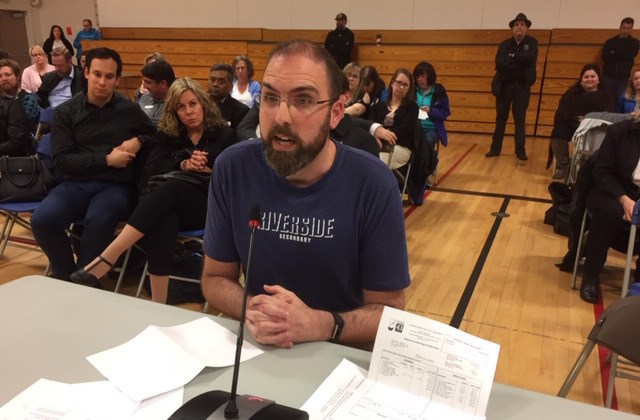School District 43 employment numbers show the district has hired hundreds of teachers and added hundreds more education assistants since cuts were made after a financial crunch six years ago.
But a budget meeting Tuesday night revealed there are still shortages in the system as educators grapple with an increase in students with mental health concerns, and more students with diagnosed special needs in a system that has been overburdened and stretched for years.
Waving his pay stub and calling on the board of education to improve working conditions for education assistants, Shamus Halvorsen, said he’s tired of having to work two jobs to make ends meet.
“We are burnt out,” Halvorsen told a crowd of about 100 people who turned out to comment on the district’s proposed school operating budget for 2019/’20.
He was among more than a dozen speakers who called on the district to find ways to relieve staff shortages and help schools deal with traumatic issues from students who have thoughts of suicide to teachers who are being injured on the job dealing with kids who have behaviour issues.
CUPE 561 president Dave Ginter received a standing ovation for his call for provincial wage and education standards for education assistants instead of the creation of a new learning inclusion support worker position.
The district is hiring 26 of these new workers, who have one year less education and are paid $23 an hour compared to $26 an hour. They’re being hired to offset a shortage of casual EAS that has resulted in schools scrambling to support students with special needs when workers are sick or on leave.
“We do struggle with respect to that side of things,” admitted Randy Manhas, the district’s human resources principal, but he said the shortage was an epidemic throughout the Metro area.
The district hopes the new LSW workers will help out in the classroom, freeing up time for EAs to work with students who have more intensive needs.
This is the first time SD43 has produced a multi-year framework projecting budget needs for the next three years, while also glancing back at the recent past.
MORE HIRES
The budget plan shows that the number of teachers has climbed from a low of 1,679 in 2014, when cuts were made for financial reasons, to nearly 2,000 now as extra teachers have been hired incrementally when finances improved and money was pumped into the system after class size and composition regulations were restored after a Supreme Court ruling.
In addition, 188 education assistants have been hired in the last six years, with another 10 new hires planned for September.
Still, there are concerns about how the district can keep its education assistants, and with CUPE 561 going into local bargaining, improved working conditions, such as increasing hours from the current 30 will be on the table, according to Ginter.
Teachers are also concerned that while their numbers are growing more support is needed to deal with vulnerable students.
MORE KIDS IN CRISIS
CTA president Ken Christensen told trustees Tuesday that teachers are struggling to keep up with the demand for support for students with behavior challenges. Some have even been injured on the job and, with the workload increasing, he called for an additional youth worker, teacher and two EAs.
“You’ll get a lot of bang for the buck here,” he promised.
Meanwhile, crisis counseling has become the norm in SD43 schools, with counsellors dealing with daily trauma from students struggling with deaths in the family and fellow students, suicidal thoughts, stress, and anxiety due to technology misuse, drug problems and even gender identity issues.
Counsellors are dealing with “emergency room scenes rather than a doctor’s office,” trustees were told as teachers complained that the current ratio of one counsellor for 523 students should be halved to make schools less stressful and students more successful.
In budget documents released last week, SD43 officials proposed a plan to spend $325.4 million for the next school year, up $10 million from the current year, with most of the extra money for spending coming from the provincial government and surpluses from previous years.
In all, 50 FTE positions will be added to the budget, including more teaching time to provide additional support for middle school gifted programs and time to free up principals to do administrative tasks. As well, four more classroom teachers will be hired to cover for projected student enrollment growth.



